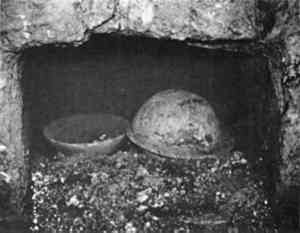FROM CODEX TO CALABASH: RECOVERY OF A PAINTED ORGANIC ARTIFACT FROM THE ARCHAEOLOGICAL SITE OF CER�N, EL SALVADORHARRIET F. BEAUBIEN
2 DISCOVERY OF A POSSIBLE CODEXDuring the 1989 field season, a layered deposit of paint fragments was found in a niche located inside an adobe domestic building (Structure 2) (McKee 1989)(fig. 1). It occupied a rectangular area measuring 18 � 15 cm and approximately 3 cm deep. Found in the niche with the deposit were three polychrome ceramic vessels, one with food remains, and a partial marine bivalve shell. Roof thatch collapsing into the building had blocked the niche opening, preventing complete inundation of the niche by subsequent surges of tephra. The deposit was relatively undisturbed, except for a superficial accumulation of ash, charred thatch, and some fallen adobe bits from the niche's ceiling. It was, however, extraordinarily fragile and in poor condition due to the complete deterioration of the organic material on which the paint was originally applied.
At the time of their discovery and during the early stages of treatment, the paint fragments were thought to constitute the remains of a codex because of the deposit's layered structure (visible along the edges) and its flattened and rectangular format. “Codex” is a term commonly used to describe the indigenous Mesoamerican form of book. This identification prompted considerable interest among Mesoamericanists for a number of reasons. Although representations of codices appear throughout the classic Maya period in wall and pottery decoration, fewer than 15 examples have survived from Maya and neighboring cultures (Coe 1980). None of these has an archaeological provenance; all are thought to be later than the 12th century and were acquired at early dates by various library collections. Typically they are constructed of a long sheet of felted amate (a fig bark) or maguey (agave cactus) fibers, folded like an accordion (von Hagen 1977). One or both sides are painted with a white sizing or ground layer followed by figural and glyph decoration using various mineral or organic pigments. The elite context of the codices is evidenced by their royal genealogical and astronomical content (Coe 1980). Given the scarcity of these objects, the rare occurrence of layered paint deposits in archaeological contexts has occasioned reports of codex remains, although none has been successfully recovered or confirmed (Kidder et al. 1946; Angulo V. 1970; Agurcia Fasquelle and Fash 1989). If Cer�n's paint remains were of a codex, its early date, secure provenance, and non-elite context would make its recovery extraordinary. |
